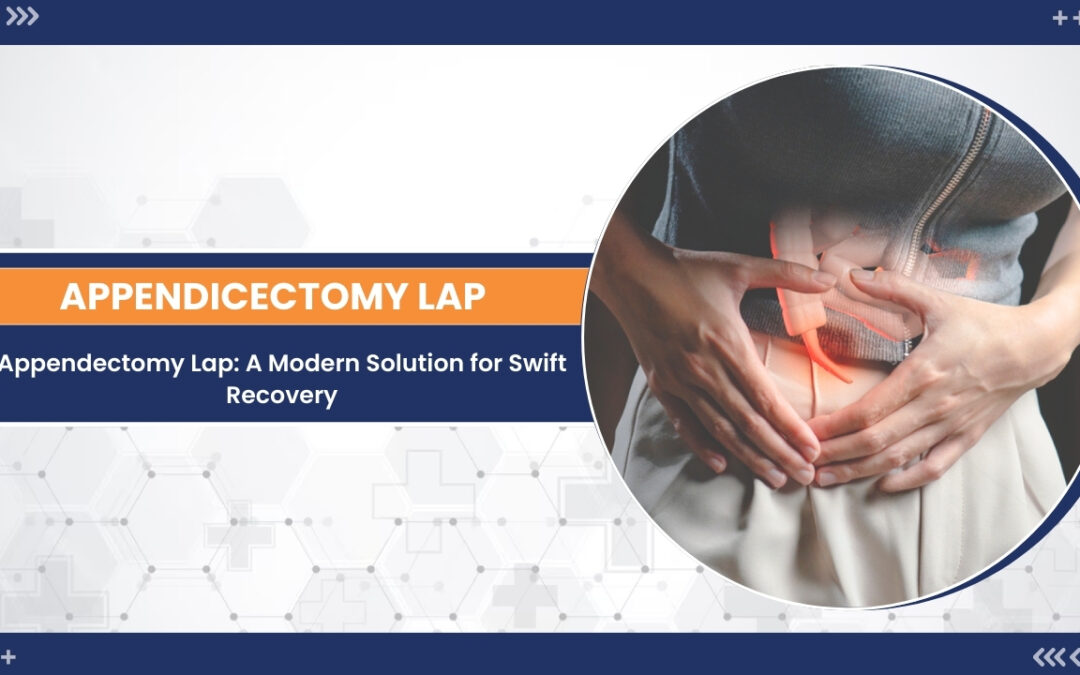Introduction to Appendectomy Lap
The Laparoscopic Appendectomy Procedure:
- Anesthesia Administration:
- The procedure begins with the administration of general anesthesia to ensure the patient is unconscious and pain-free throughout the surgery.
- Incision Placement:
- Surgeons make small incisions (usually 3-4) in the abdominal area. These incisions, typically less than an inch long, serve as entry points for the laparoscope and other specialized instruments.
- Laparoscope Insertion:
- A laparoscope, a thin tube equipped with a light source and a camera, is inserted through one of the incisions. This device provides a magnified, high-resolution image of the internal organs on a monitor, guiding the surgeon throughout the procedure.
- Instrument Insertion:
- Additional instruments, such as dissectors and graspers, are inserted through the remaining incisions. These instruments allow the surgeon to manipulate tissues, isolate the inflamed appendix, and perform the necessary steps for removal.
- Appendix Visualization:
- The laparoscope provides a clear view of the appendix and surrounding tissues, aiding the surgeon in identifying the inflamed organ and assessing the extent of the inflammation.
- Appendix Detachment:
- Using specialized instruments, the surgeon carefully detaches the inflamed appendix from its surrounding tissues. The meticulous approach minimizes trauma to the abdominal cavity.
- Appendix Removal:
- Once detached, the inflamed appendix is gently pulled through one of the small incisions. The small size of the incisions reduces trauma to the abdominal muscles, resulting in less postoperative pain and a quicker recovery.
- Closure of Incisions:
- The small incisions are closed with stitches or adhesive strips. Unlike traditional open surgery, there is no need for large sutures, contributing to reduced scarring and improved cosmetic outcomes.
Potential Complications and Considerations:
Infections, though uncommon in laparoscopic appendectomy, require vigilant postoperative care. Adhering to proper wound care protocols, including keeping incisions clean and promptly addressing any signs of infection, is essential to minimize risks and support a smooth recovery.While rare, laparoscopic appendectomy may need to be converted to open surgery if complications arise, such as challenges visualizing or accessing the appendix. This strategic decision by the surgical team ensures the safest and most effective approach, highlighting the importance of adaptability and expertise in the surgical process.
a. Infection:
- While the incidence of infection is less common with laparoscopic appendectomy, it remains a potential complication. Proper wound care is crucial to minimize the risk of infection. Patients are advised to keep the incision sites clean and dry, following postoperative care instructions meticulously. Monitoring for signs of infection, such as increased redness, swelling, or discharge from the incisions, is essential. In cases of suspected infection, prompt medical attention should be sought to address the issue and prevent further complications.
b. Conversion to Open Surgery:
- Despite the advantages of laparoscopic appendectomy, there are instances where the procedure may need to be converted to open surgery. This conversion can occur if complications arise during the laparoscopic approach, such as difficulty visualizing or safely accessing the appendix, extensive inflammation, or unexpected complications that make the laparoscopic method impractical. Surgeons make the decision to convert to open surgery in the best interest of the patient’s safety and the successful completion of the procedure
Recovery Process for Laparoscopic Appendectomy
a. Hospital Stay:
- One of the notable advantages of laparoscopic appendectomy is the reduced length of hospitalization. Typically, patients undergoing this procedure experience a shorter hospital stay compared to traditional open surgery. This is attributed to the minimally invasive nature of the surgery, which generally results in a quicker recovery and less postoperative complications.
b. Pain Management:
- Postoperative pain after laparoscopic appendectomy is generally milder in comparison to open surgery. The small incisions and targeted approach result in less trauma to the abdominal muscles, contributing to reduced pain levels. To manage any discomfort, patients are prescribed pain medication, which may include oral analgesics or non-steroidal anti-inflammatory drugs (NSAIDs). This proactive pain management approach enhances the overall patient experience during the recovery period.
c. Return to Normal Activities:
- Most patients can resume their normal activities within a relatively short timeframe after laparoscopic appendectomy. Typically, individuals can expect to return to their routine within a week. However, it’s important to note that while normal daily activities can be resumed promptly, strenuous exercise and heavy lifting may need to be avoided for a more extended period. This precaution is intended to allow the abdominal muscles to heal and reduce the risk of complications during the early stages of recovery.
Conclusion:
In the realm of appendicitis treatment, laparoscopic appendectomy emerges as a transformative paradigm, ushering in a new era of patient-centered care. Its less invasive nature not only signifies a departure from the conventional open surgery but also promises a swifter recovery trajectory. The growing preference among both surgeons and patients underscores the efficacy and advancements in modern surgical techniques. When confronted with the prospect of an appendectomy, engaging in a proactive dialogue with your healthcare provider to explore the laparoscopic option becomes pivotal, ensuring a tailored and optimal approach aligned with the unique needs of each patient.


